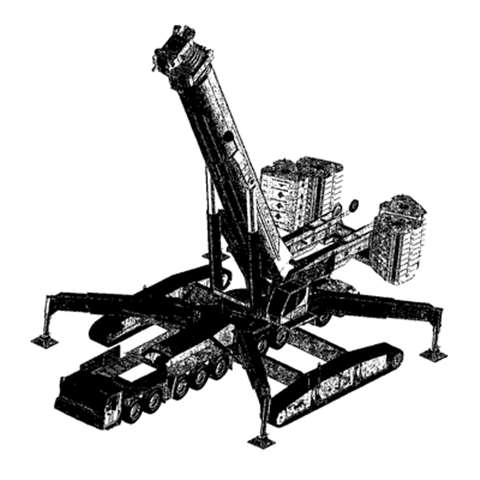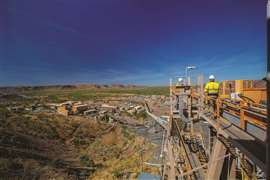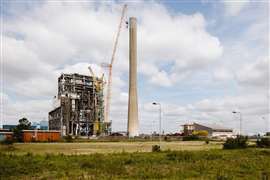Cranes: Europe's lifting sector
23 April 2008

Manitowoc Crane Group also had a good 2007, with a +45% rise in sales to US$ 3,25 billion (€ 2,08 billion), up +45% on 2006. But its order backlog also grew +88% over the course of the year to US$ 2,9 billion (€ 1,86 billion) - equivalent to 10,7 months output.
Similarly, Terex Cranes had sales of US$ 2,23 billion last year, a +28% rise on 2006, but its backlog at the end of the year stood at US$ 2,01 billion - equivalent to 11 months production.
The same is true for the major Japanese manufacturers, which are fighting hard to keep up with demand. Kobelco Cranes reported a +36,5% increase in sales for its latest financial half-year to September 2007, amounting to JPY 34,6 billion (€ 217 million). It sold 420 machines in six months, a +20% increase over the same period in 2006.
This increase, said the company, was mainly driven by "the continued sharp increase in crane orders, which are outpacing [our] ability to manufacturer and deliver products to customers."
Competition
The difficulties experienced by the more established global players in manufacturing and delivering products to their customers is providing opportunities for others to make their mark. In China, strong sales growth in the domestic market has given many manufacturers the impetus to expand outside the country.According to the China Construction Machinery Manufacturers' Association (CCMMA) exports of mobile cranes increased from 66 units (€ 4,35 million) in 2002, to 1018 units (€ 105 million) in 2006. This last figure breaks down as 770 truck cranes worth over € 76,8 million, and 123 crawler cranes worth more than € 25,6 million.
A typical example of Chinese manufacturers successful in driving exports comes from Fushun Excavator, where exports increased from € 19,2 million in 2006 to € 44,8 million (100 units) in 2007. The company is forecasting € 64 million for 2008.
At Zoomlion revenue from outside China is already 15% of total sales and, by the end of 2010, the company forecasts this will be 40%. While its best export markets are the BRIC countries (Brazil, Russia, India and China) and the Middle East Gulf countries, Western Europe, the US and Australia are the next focus.
In October a Zoomlion tower crane was delivered to Belgium and there is also a truck crane in Europe and the range of truck cranes is undergoing CE certification.
Also looking for CE certification in 2008 is Jarlway, which was previously known for its concrete pumps. It has been building tower cranes for a year and offers 11 models.
William Ho, tower crane chief, told CE two factors prompted its diversification into tower cranes. First was the strong demand in China, especially for mid-size (100 to 300 tonne-metres) and large tower cranes upwards of 300 tonne-metres. Second was the potential of the international market.
The company is currently looking for a European distributor and first in line for CE certification, said Mr Ho, are likely to be its smallest and largest models, the JT7030 and flat top JTT100, respectively.
Big lifters
If there's anything that the last few years have shown in the crane industry, it's that bigger is definitely better. The latest giant crane to see the light of day is Manitowoc's 2000 tonne capacity Model 31000, its new range-topping heavy lift crawler crane.
The quad-track 31000 was launched at March's ConExpo, Las Vegas, US. And while demand for such a monster comes from the US, where larger cranes are needed to erect bigger refinery vessels and other components, Larry Weyers, Manitowoc executive vice president of the Americas region, said the company is "creating the mega-sized Model 31000 to meet the challenging demands of global construction, where major projects require ultra high capacity cranes.Continuing Mr Weyers said the company had been receiving feedback from its heavy lift customers for some time "that the vessels and other components used in refineries, petrochemical plants and fabrication yards are growing in size [and] with the introduction of the Model 31000, we have designed an innovative and unique lifting solution."
The single boom on the Model 31000 has the company's FACT (Fast Action Connection Technology) system and will offer a range of configurations. The main boom varies from 55 to 105 m, while the fixed jibs range from 24 to 42 m. This gives a maximum main boom and fixed jib combination of 95 m plus 24 m. Luffing jibs range from 36 to 102 m and the maximum main boom and luffing jib combination is 90 m of main boom plus 102 m of luffing jib.
However, because of its immense size the 31000 needs to be transported in an incredible 85 trucks. But, other than the main boom, all the components are designed to be less than 3.5 m so transport is easier and permits are easier to get.
On site assembling the 31000 requires a 300 tonne crawler as an assist crane, a 24 m aerial work platform and a telehandler. Engineers estimate that with 60 m of main boom and 60 m of luffing jib and excellent site conditions, the Model 31000 can be assembled in 12 days with minimal crew and equipment.
Lift enhancer
One of the 31000's most interesting developments is its Variable Position Counterweight (VPC), which the company describes as a "unique lift enhancer" system that automatically extends the rear counterweight radius when more counterweight moment is needed during a lift. It then mechanically locks to prevent the counterweight from moving during operation. The mechanical actuator is controlled by the crane's EPIC control system and is deployed according to boom angle and applied load.
Another obvious difference from other heavy lift crawlers is that it is mounted on four separate crawler tracks instead of the traditional two. Benefits include "the lowest possible ground bearing pressure with reduced matting requirements and site preparation time," according to Bill O'Neil, lead engineer on the product development team.Also developing its largest crawler to date is Liebherr-Werk Ehingen in Germany. "Coming soon" will be a crawler-mounted version of its 1200 tonne capacity telescopic wheeled mobile crane, the LTM 11200-9.1. With the huge growth in alternative energy generation in Germany, and many parts of northern Europe, a typical application for the LTR 11200, said the company, will be in wind turbine parks.
Initial concepts considered the possibility of the crane being able to switch between wheels and crawler tracks but the company said this would not happen on the final design. Several units have been ordered and deliveries will start next year, a Liebherr spokesman told CE.
The boom and upper works will be from the record-breaking 1200 tonne capacity LTM 11200-9.1 telescopic wheeled mobile crane, first seen in the iron early in 2007, while the crawlers will be from its 350 tonne capacity LR 1350/1 lattice boom crawler crane.
The LTR 11200 follows in the wake of, most recently, the 100 tonne capacity LTR 1100 telescopic crawler crane. Prior to that, Liebherr's first telescopic crawler was the so-far one-off 800 tonne capacity LTR 1800. This crane used the telescopic boom upper works from the LTM 1800 telescopic wheeled mobile and the crawlers from the LR 1550. It is working in Asia.
In the iron
While the LTR 11200 is still firmly in development and testing Liebherr used last month's ConExpo to show its new LR 1600/2 crawler crane in the iron for the first time. The fully rigged 600 tonne capacity crawler can achieve maximum load with a 48 m main boom and derrick system, at a 10 m working radius. Maximum load moment is 8,085 tonne meters.The dimensions and weights of the individual components are such that the new LR 1600/2 can be moved "extremely economically", according to the company. The 74 tonne basic machine, comprising crawler centre section, slewing platform and A-frame, is 3,2 m tall, which means it can be carried on a semi low-loader.
Each crawler carrier, with 2 m-wide track pads, weighs less than 40 tonnes and can be transported economically on a 4-axle semi low-loader. No crane components exceed 3 m transport width, added the company.
One of the most interesting, and biggest cranes from Terex Demag in recent months is its new 3200 tonne capacity CC 8800-1 Twin lattice boom crawler crane with two booms. Unveiled at the end of last year the company claims it is the largest mobile pick and carry crane in the world.
The lifting power of the parallel double booms quadruples the lifting power of the single boom CC8800-1, on which it is based. The modular boom design makes it suitable for a wide range of applications - refinery, power station or infrastructure construction.
The main boom is up to 117 m long and can be combined with a luffing fly jib of up to 117 m, giving a maximum hook height of more than 235 m.
All the accessories from the CC 8800-1 can be used on the Twin, for example, the runner or the light fixed jib to 370 tonnes. All CC 8800-1s can be rigged with a Twin kit, and share all accessories, meaning a Twin kit can also be loaned to other operators of CC 8800-1s.
Elsewhere, the 360 tonne capacity ATF 360G-6 is Tadano Faun's new flagship telescopic wheeled mobile crane on six axles. It has a 60 m main boom and new jib design. Launched at last year's Bauma the company has only just started production.
New in its rough terrain range is the 55 tonne capacity GR-550EX, which fits between the 30 tonne GR-300EX and the 70 tonne GR-700EXL. The main boom is 42 m and the 17 m bi-fold extension is standard.
Future developments
There is no doubt the last 12 months have been particularly successful for many crane manufacturers. The demand for larger capacity crawler cranes in particular looks like continuing, so contractors can look forward to more new machines in the coming months, not least from China.
Sany for one has plans to add to its range. At last year's ConExpo Asia the company showed its SCC1500C crawler crane and announced plans to build machines all the way up to - and beyond - 1600 tonnes capacity.
Liebherr is also developing an "XXL" crawler crane with more than 2000 tonnes lifting capacity. The as-yet unnamed lattice boom crawler will be a conventional single boom and two-crawler design - "A quite normal design - just bigger," a Liebherr spokesperson told CE.
What this should mean for lifting contractors is more choice, which in turn should mean more competition and, perhaps, lower prices.
STAY CONNECTED


Receive the information you need when you need it through our world-leading magazines, newsletters and daily briefings.
CONNECT WITH THE TEAM










